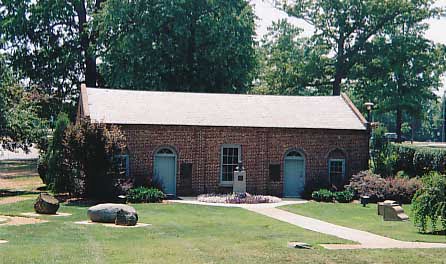Moving Day
 Thomas Goulding, George Howe, Aaron Leland, Benjamin Morgan Palmer, James Henry Thornwell, William S. Plumer, Joseph R Wilson, John L. Giarardeau, Charles Colcock Jones, Francis R. Beattie — if you live outside the southern states of this great land, you may not have any recognition of these men and their important place in God’s kingdom. But if you reside within the southern states, these are the worthies of the cross associated with Columbia Theological Seminary, and the southern visible church.
Thomas Goulding, George Howe, Aaron Leland, Benjamin Morgan Palmer, James Henry Thornwell, William S. Plumer, Joseph R Wilson, John L. Giarardeau, Charles Colcock Jones, Francis R. Beattie — if you live outside the southern states of this great land, you may not have any recognition of these men and their important place in God’s kingdom. But if you reside within the southern states, these are the worthies of the cross associated with Columbia Theological Seminary, and the southern visible church.
» Pictured at right, Dr. John L. Girardeau [1825-1898] »
It was on April 1, 1824, that the Presbytery of Southern Carolina began the first steps to organize a theological seminary to serve the entire Southeastern part of the country. Up to this date, there were only four Presbyterian seminaries in operation, namely, Andover in Massachusetts, New Brunswick in New Jersey, Princeton, also in New Jersey, and Auburn in New York. The new seminary, known later as Columbia, began in Lexington, Georgia with one professor (Thomas Goulding) and five students. Later, the theological school was moved to Columbia, South Carolina, with two teachers (Goulding, and Thomas Howe) and six students. Two of the six became foreign missionaries. Between that year of 1830 and 1910, the membership of the Presbyterian Church, U.S. (aka, Southern) rose from 10,000 members to 70,000 members. And the seven hundred and fifty candidates of the gospel ministry who went through those hallowed halls would minister to that remarkable3 growth of the visible church.
 Then in the second decade of the twentieth century, there was a geographic shift in the population of the southeastern United States, such that Atlanta, Georgia became the unofficial capital of that area. In response, Columbia Theological Seminary began a $250,000 endowment campaign on February 10, 1925 as part of a strategic plan to relocate the Seminary, from the city which gave it its name, to Decatur, Georgia, just outside Atlanta. That move was accomplished in the year of 1930. Today, Columbia Seminary is one of ten seminaries of the Presbyterian Church U.S.A.
Then in the second decade of the twentieth century, there was a geographic shift in the population of the southeastern United States, such that Atlanta, Georgia became the unofficial capital of that area. In response, Columbia Theological Seminary began a $250,000 endowment campaign on February 10, 1925 as part of a strategic plan to relocate the Seminary, from the city which gave it its name, to Decatur, Georgia, just outside Atlanta. That move was accomplished in the year of 1930. Today, Columbia Seminary is one of ten seminaries of the Presbyterian Church U.S.A.
« To the left: This building—designed by Robert Mills—was the chapel of Columbia Theological Seminary when the seminary was located in Columbia, South Carolina. Mills had designed the building as the carriage house for the Ainsley Hall mansion. The chapel building was relocated to the property of Winthrop College in 1936. [photograph by Barry Waugh, 18 July 2006]
Statistical trivia: Among the founding fathers of the PCA, the overwhelming majority of these pastors were educated at Columbia Theological Seminary:
5 — Austin Presbyterian Theological Seminary, 1929, 1939, 1942, 1953
2 — Biblical Seminary, 1961, 1963
83 – Columbia Theological Seminary, 1934-1970
2 — Dallas Theological Seminary, 1937, 1941
3 — Erskine Theological Seminary, 1953, 1966
2 — Faith Theological Seminary, 1948, 1955
3 — Fuller Theological Seminary, 1953, 56, 59
2 — Gordon-Conwell Theological Seminary, 1953, 1970
1 — Grace Theological Seminary, 1970
2 — Louisville Presbyterian Theological Seminary, 1942, 1955
1 — New Orleans Baptist Theological Seminary, 1965
1 — Northwestern Evangelical Seminary, 1938
1 — Pittsburgh-Xenia Theological Seminary, 1951
2 — Princeton Theological Seminary, 1928, 1954
1 — Reformed Episcopal Seminary, 1952
35 – Reformed Theological Seminary, Jackson, MS 1969-1973 [RTS opened its doors in the fall of 1966]
1 — Seabury-Western Theological Seminary, 1957
1 — Toronto Bible College 1948
14 – Union Theological Seminary, Richmond, VA, 1919-1968
15 – Westminster Theological Seminary, 1929-1972
1 — WTNC, 1934
1 — Wheaton College, 1939 [James R. Graham, D.D.]
Words to Live By: Statistics say that the average American family will move every seven years of his life and work. Of course, there are always exceptions to this rule, and you reader might say that you have lived in the same location all of your life! But whether you move or stay in one location, Christ describes us as the salt of the earth and the light of the world. As salt, we are to flavor our circumstances in life as well as restrain the corruption which is all around us in varying degrees. As light, we are to shine forth the rays of the gospel, especially to reveal the sinfulness of our culture, for the world is in spiritual darkness. As Christians remember their calling, there will bloom wherever they are planted, whether they move frequently or remain in one location all of their lives.
